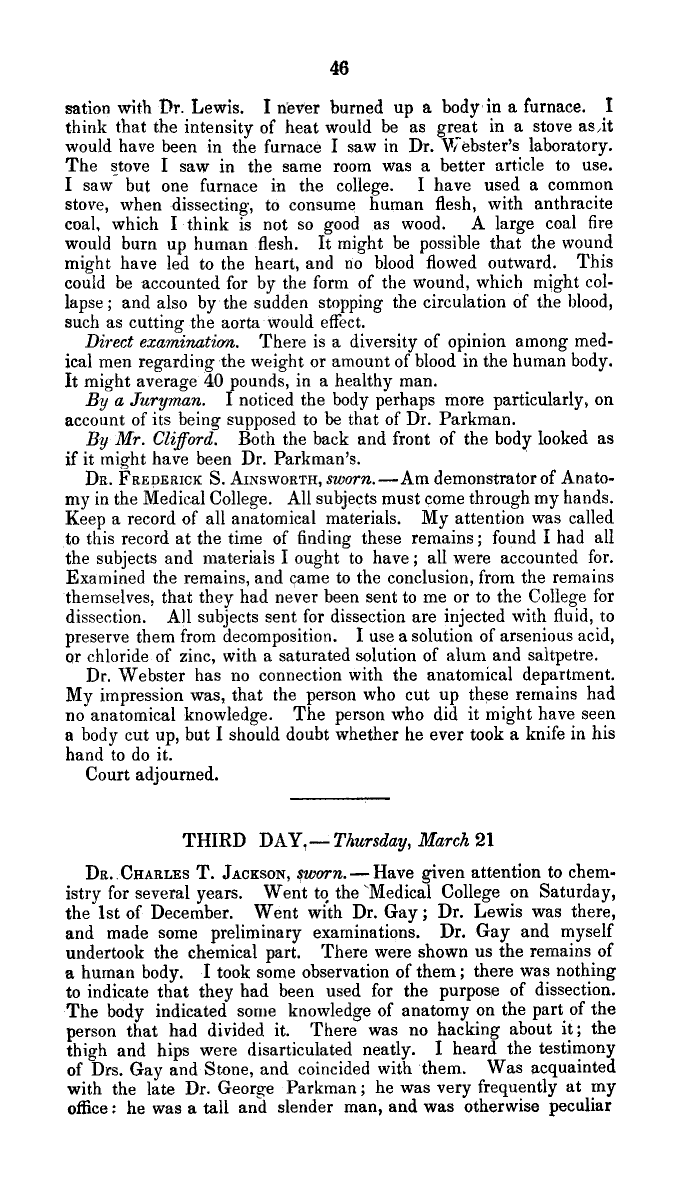|
46
sation with Dr. Lewis. I never burned up a body in a furnace. I
think that the intensity of heat would be as great in a stove as,it
would have been in the furnace I saw in Dr. Webster's laboratory.
The stove I saw in the same room was a better article to use.
I saw but one furnace in the college. I have used a common
stove, when dissecting, to consume human flesh, with anthracite
coal, which I think is not so good as wood. A large coal fire
would burn up human flesh. It might be possible that the wound
might have led to the heart, and no blood flowed outward. This
could be accounted for by the form of the wound, which might col-
lapse; and also by the sudden stopping the circulation of the blood,
such as cutting the aorta would effect.
Direct examination. There is a diversity of opinion among med-
ical men regarding the weight or amount of blood in the human body.
It might average 40 pounds, in a healthy man.
By a Juryman. I noticed the body perhaps more particularly, on
account of its being supposed to be that of Dr. Parkman.
By Mr. Clifford. Both the back and front of the body looked as
if it might have been Dr. Parkman's.
DR. FREDERICK S. AINSWORTH, sworn.-Am demonstrator of Anato-
my in the Medical College. All subjects must come through my hands.
Keep a record of all anatomical materials. My attention was called
to this record at the time of finding these remains; found I had all
the subjects and materials I ought to have; all were accounted for.
Examined the remains, and came to the conclusion, from the remains
themselves, that they had never been sent to me or to the College for
dissection. All subjects sent for dissection are injected with fluid, to
preserve them from decomposition. I use a solution of arsenious acid,
or chloride of zinc, with a saturated solution of alum and saltpetre.
Dr. Webster has no connection with the anatomical department.
My impression was, that the person who cut up these remains had
no anatomical knowledge. The person who did it might have seen
a body cut up, but I should doubt whether he ever took a knife in his
hand to do it.
Court adjourned.
THIRD DAY,-Thursday, March 21
DR..CHARLEs T. JACKSON, sworn.-Have given attention to chem.
istry for several years. Went to the 'Medical College on Saturday,
the 1st of December. Went with Dr. Gay; Dr. Lewis was there,
and made some preliminary examinations. Dr. Gay and myself
undertook the chemical part. There were shown us the remains of
a human body. I took some observation of them; there was nothing
to indicate that they had been used for the purpose of dissection.
The body indicated some knowledge of anatomy on the part of the
person that had divided it. There was no hacking about it; the
thigh and hips were disarticulated neatly. I heard the testimony
of Drs. Gay and Stone, and coincided with them. Was acquainted
with the late Dr. George Parkman ; he was very frequently at my
office: he was a tall and slender man, and was otherwise peculiar
|

